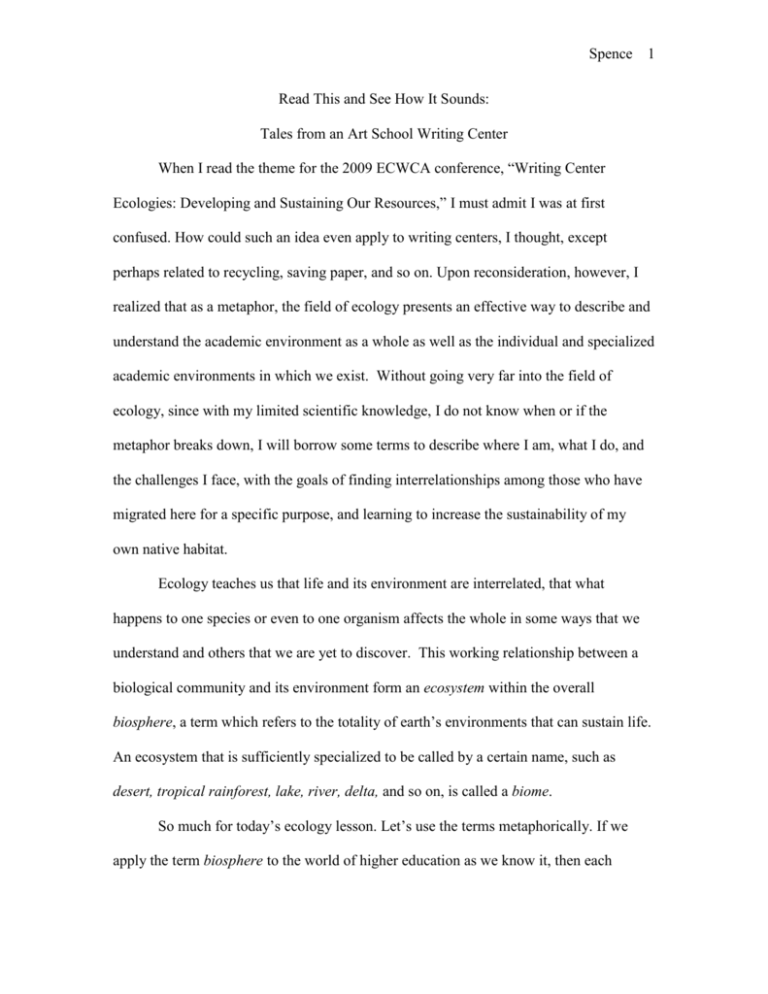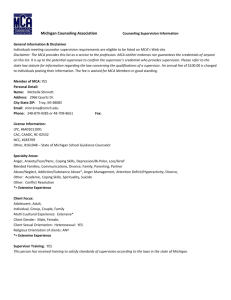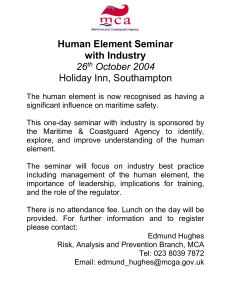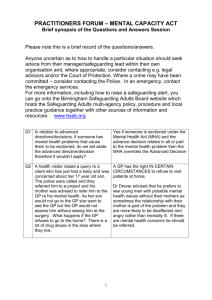Read This and See How It Sounds: Tales from an Art School
advertisement

Spence 1 Read This and See How It Sounds: Tales from an Art School Writing Center When I read the theme for the 2009 ECWCA conference, “Writing Center Ecologies: Developing and Sustaining Our Resources,” I must admit I was at first confused. How could such an idea even apply to writing centers, I thought, except perhaps related to recycling, saving paper, and so on. Upon reconsideration, however, I realized that as a metaphor, the field of ecology presents an effective way to describe and understand the academic environment as a whole as well as the individual and specialized academic environments in which we exist. Without going very far into the field of ecology, since with my limited scientific knowledge, I do not know when or if the metaphor breaks down, I will borrow some terms to describe where I am, what I do, and the challenges I face, with the goals of finding interrelationships among those who have migrated here for a specific purpose, and learning to increase the sustainability of my own native habitat. Ecology teaches us that life and its environment are interrelated, that what happens to one species or even to one organism affects the whole in some ways that we understand and others that we are yet to discover. This working relationship between a biological community and its environment form an ecosystem within the overall biosphere, a term which refers to the totality of earth’s environments that can sustain life. An ecosystem that is sufficiently specialized to be called by a certain name, such as desert, tropical rainforest, lake, river, delta, and so on, is called a biome. So much for today’s ecology lesson. Let’s use the terms metaphorically. If we apply the term biosphere to the world of higher education as we know it, then each Spence 2 institution of higher learning would certainly qualify as its own “ecosystem,” and “biomes” would be called “large state university,” “small private liberal arts college,” and so on. Somewhere in the schema of all academic biomes would be found, in about forty instances across the country, the “independent college of art and design.” And thus I have pinpointed the environment, the “biome,” from which I have appeared in your midst: Memphis College of Art. I may be the only member of my species here. Background Let me describe my particular “biome.” Memphis College of Art, or MCA, was founded in 1936 as Memphis Academy of Arts and changed its name to Memphis College of Art during the 1980s; many members of the surrounding community still refer to the school as “The Academy.” All undergraduate programs are under one roof, known as Rust Hall, completed in 1959. This “biome” is located in midtown Memphis within historic Overton Park. No need for the viewbooks to describe a “park-like” setting for MCA––it’s actually in a large, urban park, next door to a world-class zoo on one side and Tennessee’s premier art museum, Brooks Museum of Art, on the other. MCA focuses on both fine arts and design arts, with programs encompassing traditional arts such as drawing, painting, sculpture, and printmaking, and digitally based arts such as animation, digital cinema, and graphic design, as well as those arts that have begun to evolve from traditional media to digital, such as illustration and photography. Degrees offered include the BFA, MFA, MAT, and MA in Art Education. Total enrollment in all programs is approximately four hundred students. Spence 3 Overview of Writing Center Having come from a traditional state university “biome,” I have had to adapt to this small, extremely specialized environment. All the students, obviously, are art majors. Although applicants must meet basic academic standards for admission, the selectivity of the school is based primarily on portfolio review rather than academic achievement. Thus this small environment consists of artistically gifted students with a wide range of academic abilities, and the students benefit from a writing center at MCA in exactly the same way as they do in more standard academic environments. When I was hired full time at the college in 2001, the dean named my position Learning Center Director and charged me with developing a tutoring center (with no budget and no staff) within an established “writing lab” consisting of seventeen computers and designed for writing classes and individual student use. This responsibility was in addition to teaching two sections of freshman composition each semester and coordinating the freshman writing program. About a week later, the dean called back to say that he also wanted me to chair the Division of Liberal Studies. (Liberal Studies at MCA comprises all of the liberal arts that provide the college’s general education.) I accepted all of these responsibilities, knowing that there would be challenges, not the least of which was that I would be spread pretty thin in my new environment. Challenges The first challenge, however, was space. The “learning” or writing center was originally located in the aforementioned lab, but with increasing digitally-based classes and demand for Internet access, the lab became overcrowded with general use, and the Spence 4 round table in the middle, where I did one-on-one tutoring, became a little too public, so the writing center gradually moved to my office. There, space is of course an issue. After I spent several years making multiple requests for a workable space and surviving an administration change, the next dean offered me a much larger area, but in a much more remote location, adjacent to some studio space on the top floor and quite out of the mainstream; I had to turn this offer down because I knew students would not naturally venture there. If not accessible, writing centers sit empty and die a natural death, and I did not want that to happen at MCA. Luckily, my office is in a high traffic area, a distinct advantage in attracting students, so I stayed there. I then hit upon another plan. The upper floors of MCA, where I am located, were originally built as sort of blank canvases, and walls can be erected and removed with ease, according to changing need. An unused area about ten feet from my office afforded enough space for a small writing center, but just as I was planning my strategy to convert this space, I stepped out of the elevator one day to find a new room built on that very spot for the sole purpose of housing a large format color printer! The writing center is still my office, and space is still a problem. In addition to doubling as a writing center, my office provides desk space for three adjunct writing instructors who teach in the late afternoons, and very often we are on top of one another: while they need to use the extra desk in the office to get organized for class, I need it for tutoring. I can sometimes schedule around the late afternoon hours, but that does not account for walk-ins. Another important challenge that I face daily is being only one person. Although writing center business is not always booming, I occasionally have to turn students away during busy times of the semester. Sometimes an enthusiastic faculty member wants to Spence 5 require every student in class to visit the writing center as part of a particular assignment, and I must discourage that practice because there are not enough hours in the day for one person to see twelve to fifteen or more students within the required time frame, especially knowing that most students will procrastinate. Besides, I firmly believe that a student’s first authentic act as a writer is visiting the writing center voluntarily. It would seem that peer tutors would be a solution to the staffing issues. Now that the Liberal Studies chair position that I accepted seven years ago has recently rotated to another faculty member, one of my responsibilities is lifted, and I have begun in earnest to ponder solutions to the most pressing writing center matters. Knowing that peer tutoring has been used in many schools with great success, I am interested in establishing such a program at MCA. The time may be right, since a consulting firm has recently suggested that we create more meaningful work-study jobs; hiring students as peer writing tutors provides the perfect opportunity to do just that. However, a roadblock exists: we have no English majors, and, even though good writers sometimes appear, most have little interest in devoting their time to anything besides their art. Who can blame them? This past week I interviewed a student who came to MCA with a degree in English and is working toward her degree in drawing; she is interested in using both her skill sets to connect with students by working in the writing center. This situation holds some possibilities, but I’m afraid she is an anomaly in the system, difficult if not impossible to replace once she moves on. I do not know if a peer tutoring program is sustainable at MCA or not. Kirsten Komara’s article in the December 2008 Writing Lab Newsletter, “Creating an Effective Writing Center: Solving the Dilemma of Hiring Good Spence 6 Tutors,” has given me an excellent template for setting up hiring practices when or if I am able to implement such a program at MCA. A third challenge presents itself as both blessing and curse: the familiarity level I have with other faculty. I read with interest Jennifer Jefferson’s article in the March 2009 Writing Lab Newsletter, “Knowing the Faculty (Too?) Well: An Advantage or Disadvantage for Small College Writing Centers?” Many of my own issues are mirrored in the experiences described. When I find myself interpreting for a student what I know that his or her professor wants, am I really doing that student any favors? Or am I disseminating “inside information” that may seem to give the student an unfair advantage or put me in the position of doing the professor’s job, or worse yet, put me in potential conflict with the professor? I learned a lesson in this area the hard way several years ago while still a neophyte in the tutoring business. A student requested that I go over a paper with him; let’s call him Student X. After we had finished discussing strengths and weaknesses, he asked the question: “What grade would you give this?” Still operating more in instructor mode than in tutor mode, I answered that I would give it somewhere in C range. It turned out that this paper had already been submitted and graded. Student X was dissatisfied with the grade and wanted to involve me as an “expert witness” in a grade dispute. I was able to extract myself from this trap and made it policy as tutor never to discuss grades from that point forward. As both professor and tutor, I also have a potential conflict of interest. Until recently, as Liberal Studies chair I was the professors’ supervisor as well as the students’ tutor––a difficult tightrope to walk. I no longer have that conflict, but what about the conflict with myself? My own students have no additional sounding board for their Spence 7 writing besides their own professor who also happens to run the writing center, and although on the surface this arrangement may seem ideal, in actuality it deprives them of the chance to have an impartial reader. Then there is the dilemma of proofreading. Some professors want “cleaned up” papers so that they don’t have to struggle to read them, so proofreading is what they actually expect when they send a student to the writing center. I, on the other hand, adhering to Stephen North’s writing center ideology, am more interested in producing “better writers” than “better writing” (438). Requests for proofreading are sometimes couched in phrasings such as “Would you read this and see how it sounds?” I respond by telling the student, “I will as long as you will read it with me. We’ll look over it together.” Which brings me to the case of Student Y. A junior graphic design major, Student Y is known for his work ethic, and faculty know that he has a hard time financially. He has long since completed his writing requirement. He showed up at the writing center with an application for a summer job as a camp counselor. Part of the application was to write an essay. He considered the essay almost finished and wanted a second pair of eyes to look over his final draft. I agreed to do it. On beautifully designed personal letterhead, he had written an essay without once thinking of capitalizing the pronoun I, had used spellcheck to turn the word counselor into consoler, and had written the word outweigh as out way. The deadline was looming, and he had his laptop with him, so I proofread, and he made the corrections, from start to finish. Unethical? I’m not sure. But that’s what happened. Spence 8 Advantages The challenges in the art school “biome” are many, yet the environment is not without its advantages. The “biome” is small; thus my outreach need not be intensive. Students who have had positive experiences tell others and sometimes even bring their friends to my door. I see students both by appointment and on a walk-in basis. Many students I already know by name. I occasionally put an ad in the student newsletter, which brings in a few students. Additionally, I forge relationships with a special group of freshmen each semester. We have one developmental composition class of approximately fifteen students, and each student is required to visit the writing center for one hour of tutoring per week for five weeks. This requirement may seem to run counter to the philosophy of voluntary visits, but it turns out that these students are the most likely to visit the writing center in successive semesters since, through fulfilling a requirement, they have found valuable help and support there. I also have a close working relationship with faculty and know the entire faculty on a first-name basis. I send out occasional reminders to faculty to encourage their students to visit the writing center. Conclusion Let me leave you with the story of Student Z, who was strongly encouraged to visit the writing center by his second semester composition instructor. The instructor warned me that Student Z might be obstinate, since instructions for the paper had clearly stated, “No contractions,” and the student’s paper was filled with contractions. Student Z came at the appointed time. As we delved into the strengths and weaknesses of the paper that he was to revise, it became apparent that he did not know what a contraction was, and this was just the beginning of what he did not know. He had completed Spence 9 developmental and first semester composition at another school and had transferred to MCA. Somehow the knowledge and skills from those courses had not stuck. Far from obstinate, Student Z was eager to fill these unexplained gaps in his knowledge; he now eagerly meets with me twice a week and is making progress. The story does not end here. With the knowledge and enthusiasm that I undoubtedly with take back with me from this conference, I will be able to improve and enhance MCA’s writing center, thus equipping the next generation of visual artists with the verbal skills that they need for the 21st century. Spence 10 Works Cited Jefferson, Jennifer. “Knowing the Faculty (Too?) Well: An Advantage or Disadvantage for Small College Writing Centers?” Writing Lab Newsletter 33.7 (2009): 1-5. Print. Komara, Kirsten. “Creating an Effective Writing Center: Solving the Dilemma of Hiring Good Tutors.” Writing Lab Newsletter 33.4 (2008): 1-4. Print. North, Stephen. “The Idea of a Writing Center.” College English 46.5 (1984): 433-46. JSTOR. Web. 1 Apr. 2009.






